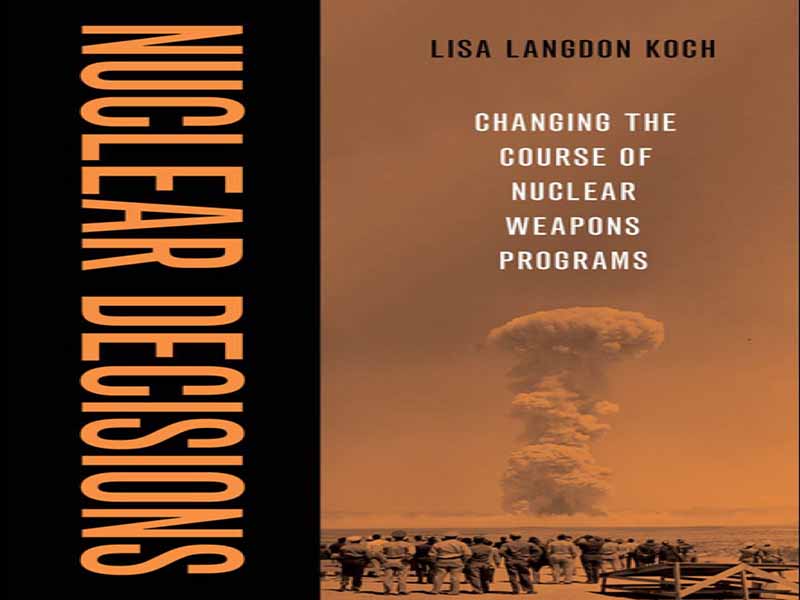- عنوان: Nuclear Decisions – Changing the Course of Nuclear Weapons Programs
- نویسنده: Lisa Langdon Koch
- حوزه: سلاح هستهای
- سال انتشار: 2023
- تعداد صفحه: 289
- زبان اصلی: انگلیسی
- نوع فایل: pdf
- حجم فایل: 15.0 مگابایت
سوابق تاریخی نشان می دهد که دولت ها برنامه های تسلیحات هسته ای را آغاز نمی کنند و سپس به طور یکنواخت مسیرهای خطی را برای رسیدن به یک هدف منحصر به فرد دنبال نمی کنند. یک توضیح احتمالی برای پیشرفت نامنظم، مداخله سیاسی در تحقیق و توسعه علمی است. ژاک ای سی هیمانز استدلال میکند که رهبرانی که توسط نهادهای دولتی محدود نشدهاند، اغلب در برنامههای تسلیحات هستهای مداخله میکنند و ناخواسته پیشرفت به سمت بمب را مختل میکنند. اینکه آیا دانشمندان آزادند کار خود را به گونهای دنبال کنند که باعث پیشرفت تحقیقات و توسعه خوب شود یا در عوض با انگیزههای قوی برای دلجویی از رهبران سرکوبگر از طریق میانبرها و گزارشهای نادرست مواجه شوند، باید بر جدول زمانی برنامه تأثیر بگذارد. با این حال، این استدلال قانع کننده در مورد زمان تا نتیجه نمی تواند شکل برنامه تسلیحات هسته ای را توضیح دهد. به طور ضمنی در استدلال هایمنز این مفروضات وجود دارد که دولت ها یک هدف مشترک دارند – تولید سریع سلاح های هسته ای – و مسیرهای خطی را برای رسیدن به بمب در پیش می گیرند. مشاهده این که تعداد کمی از ایالت ها به نتیجه ای سریع دست یافته اند، هیمنز را به این نتیجه رساند که مشکلی پیش آمده است. با این حال، در حالی که مسابقه برای رسیدن به بمب در اوایل جنگ سرد رایجتر بود، در بیشتر دوران هستهای، رویکرد پیشروی کامل استثنا بوده است، نه یک قاعده. در عوض، رهبران طیف وسیعی از ترجیحات را در مورد اهمیت و ضرورت دستیابی سریع به زرادخانه هسته ای نشان داده اند. اگر این مسیرهای غیرخطی یک انحراف نباشند – اگر توسعه سلاحهای هستهای در عوض به طور معمول غیرخطی باشد – تداخل در مدیریت پروژه نمیتواند توضیح کافی باشد. من استدلال می کنم که مسیرهای رسیدن به بمب به ندرت خطی هستند زیرا با تصمیمات هسته ای قطع شده و اصلاح می شوند. رهبران ممکن است به برنامه تسلیحات هسته ای اجازه دهند مسیری را که در آن است حفظ کند یا حتی تصمیم بگیرند که توسعه آن را کند یا تعلیق کنند. سازمانهای داخلی منبع کلیدی اطلاعات تخصصی هستند که درک رهبر از ارزش و هدف استراتژیک برنامه هستهای را شکل میدهند. توضیح احتمالی دیگر این است که تغییرات در محیط امنیتی باعث می شود که یک ایالت به سمت بمب حرکت کند یا از آن دور شود. نگرانی های امنیتی یک انگیزه مهم برای تصمیم اولیه برای شروع برنامه تسلیحات هسته ای است. با این حال، توضیح امنیتی نیز کافی نیست. کشورهایی که تصمیم به شروع برنامه ای می گیرند ممکن است سال ها قبل از انتخاب مسیر هسته ای در ناامنی به سر ببرند. و هنگامی که یک برنامه تسلیحات هسته ای در حال انجام است، به نظر می رسد بسیاری از رهبران تصمیمات هسته ای را اتخاذ می کنند که مبتنی بر محیط های امنیتی خارجی پایدار یا متغیر نیست. اگر امنیت تنها محرک تصمیمهای هستهای بود، انتظار داشتیم در زمانهای ناامنی بالا، تصمیمهای شتابدهی و در زمان ناامنی پایین تصمیمهای معکوس را ببینیم. مطالعات موردی که من در این کتاب انجام می دهم وجود چنین پویایی را نشان نمی دهد. به عنوان مثال، برنامه هند در اواسط تا اواخر دهه 1970 به طور قابل توجهی کند شد، علیرغم پیشرفت سلاح های هسته ای در رقبای منطقه ای خود، چین و پاکستان. کره جنوبی با بدتر شدن محیط امنیتی برنامه خود را تسریع نکرد. برزیل علیرغم تغییر اندک یا بدون تغییر در محیط امنیتی خود، از دستیابی به سلاح های هسته ای دست کشید. آفریقای جنوبی علیرغم برتری نظامی قابل توجه منطقه ای خود، به سمت یک زرادخانه هسته ای دوید. شاید نگرانی عمیق در مورد مداخله شوروی در آفریقای جنوبی، یا حتی ترس از تهاجم، بتواند منحنی تکثیر آفریقای جنوبی را توضیح دهد – اما پس چرا پرتوریا دو تغییر برنامه متفاوت را خیلی قبل از سقوط اتحاد جماهیر شوروی اجرا کرد؟
The historical record demonstrates that states do not initiate nuclear weapons programs and then uniformly follow linear paths to a singular goal. One possible explanation for erratic progression is political meddling in scientific research and development. Jacques E. C. Hymans argues that leaders who are unconstrained by state institutions often interfere in nuclear weapons programs, unintentionally disrupting progress toward the bomb. Whether scientists are free to pursue their work in ways that will advance good research and development or instead face strong incentives to appease repressive leaders through shortcuts and false reporting should affect a program’s timeline. This compelling argument about time- to- outcome, however, cannot explain the form a nuclear weapons program takes. Implicit in Hymans’s argument are the assumptions that states have a common goal— to quickly produce nuclear weapons— and take linear paths to the bomb. The observation that few states had obtained a speedy outcome led Hymans to conclude that something had gone wrong. However, while racing to the bomb was more common during the early Cold War, for most of the nuclear age the full- speed- ahead approach has been the exception, not the rule. Rather, leaders have exhibited a range of preferences regarding the importance and necessity of quickly acquiring a nuclear arsenal. If these nonlinear pathways are not a deviation— if nuclear weapons development is instead typically nonlinear— then interference with project management cannot be a sufficient explanation. I argue that the paths to the bomb are rarely linear because they are interrupted and reformed by nuclear decisions. Leaders may allow a nuclear weapons program to maintain the course it is on or even decide to slow or suspend its development. Domestic organizations are a key source of expert information that shapes the leader’s perception of the value and strategic purpose of the nuclear program. Another possible explanation is that changes in the security environment prompt a state to move toward or away from the bomb. Security concerns are an important motivator for the initial decision to start a nuclear weapons program. Yet the security explanation, too, is insufficient. States that do decide to begin a program may exist in insecurity for years before choosing the nuclear path. And once a nuclear weapons program is underway, many leaders appear to make nuclear decisions that are not based on either stable or changing external security environments. If security were the sole driver of nuclear decisions, we would expect to see acceleration decisions during times of high insecurity and reversal decisions during times of low insecurity. The case studies I conduct in this book do not indicate the presence of such a dynamic. For example, India’s program slowed significantly in the mid- to late 1970s, despite nuclear weapons progress in its regional rivals, China and Pakistan. South Korea did not accelerate its program when its security environment worsened. Brazil gave up its pursuit of nuclear weapons despite little to no change in its security environment. South Africa sprinted toward a nuclear arsenal despite its significant regional military superiority. Perhaps deep concerns over Soviet interference in southern Africa, or even fears of invasion, could explain South Africa’s proliferation curve instead— but then why did Pretoria implement two different program reversals, well before the fall of the Soviet Union?
این کتاب را میتوانید از لینک زیر بصورت رایگان دانلود کنید:
Download: Nuclear Decisions – Changing the Course of Nuclear Weapons Programs



































نظرات کاربران